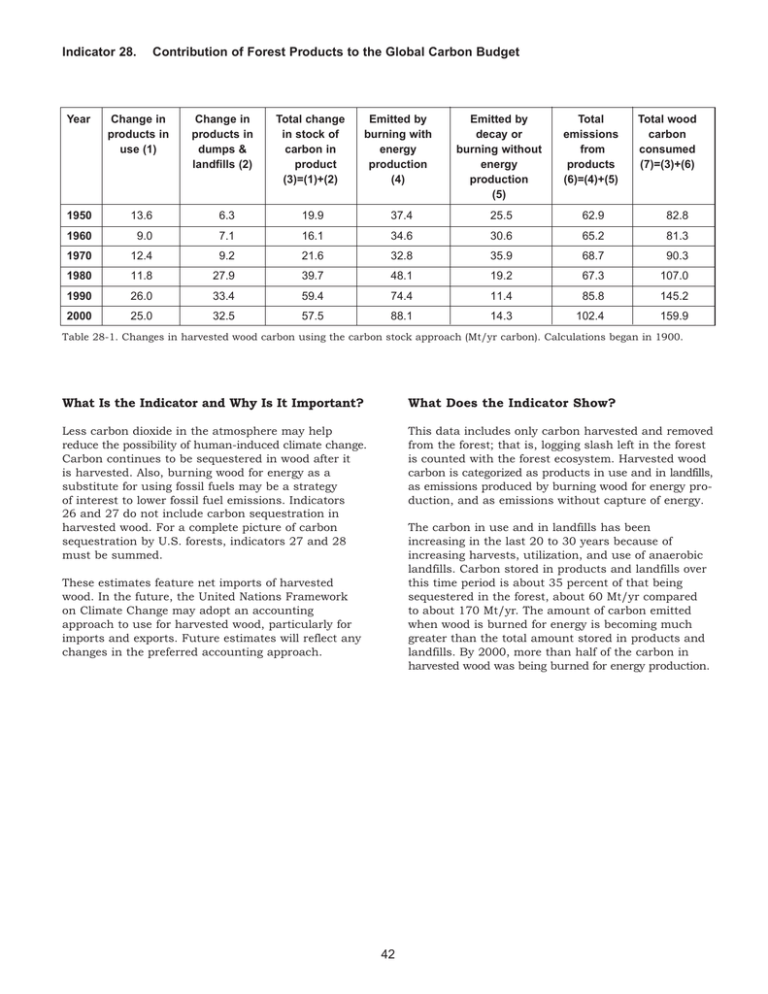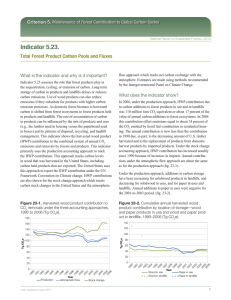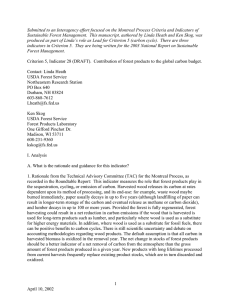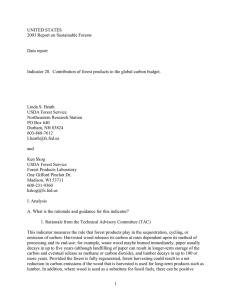Indicator 28. Contribution of Forest Products to the Global Carbon Budget
advertisement

Indicator 28. Contribution of Forest Products to the Global Carbon Budget Year Change in products in use (1) Change in products in dumps & landfills (2) Total change in stock of carbon in product (3)=(1)+(2) 1950 13.6 6.3 19.9 1960 9.0 7.1 1970 12.4 1980 Emitted by burning with energy production (4) Emitted by decay or burning without energy production (5) Total emissions from products (6)=(4)+(5) Total wood carbon consumed (7)=(3)+(6) 37.4 25.5 62.9 82.8 16.1 34.6 30.6 65.2 81.3 9.2 21.6 32.8 35.9 68.7 90.3 11.8 27.9 39.7 48.1 19.2 67.3 107.0 1990 26.0 33.4 59.4 74.4 11.4 85.8 145.2 2000 25.0 32.5 57.5 88.1 14.3 102.4 159.9 Table 28-1. Changes in harvested wood carbon using the carbon stock approach (Mt/yr carbon). Calculations began in 1900. What Is the Indicator and Why Is It Important? What Does the Indicator Show? Less carbon dioxide in the atmosphere may help reduce the possibility of human-induced climate change. Carbon continues to be sequestered in wood after it is harvested. Also, burning wood for energy as a substitute for using fossil fuels may be a strategy of interest to lower fossil fuel emissions. Indicators 26 and 27 do not include carbon sequestration in harvested wood. For a complete picture of carbon sequestration by U.S. forests, indicators 27 and 28 must be summed. This data includes only carbon harvested and removed from the forest; that is, logging slash left in the forest is counted with the forest ecosystem. Harvested wood carbon is categorized as products in use and in landfills, as emissions produced by burning wood for energy production, and as emissions without capture of energy. The carbon in use and in landfills has been increasing in the last 20 to 30 years because of increasing harvests, utilization, and use of anaerobic landfills. Carbon stored in products and landfills over this time period is about 35 percent of that being sequestered in the forest, about 60 Mt/yr compared to about 170 Mt/yr. The amount of carbon emitted when wood is burned for energy is becoming much greater than the total amount stored in products and landfills. By 2000, more than half of the carbon in harvested wood was being burned for energy production. These estimates feature net imports of harvested wood. In the future, the United Nations Framework on Climate Change may adopt an accounting approach to use for harvested wood, particularly for imports and exports. Future estimates will reflect any changes in the preferred accounting approach. 42







